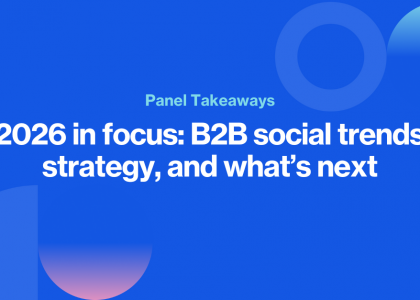
Imagine you are a talented track athlete who is about to run a 100-yard dash. Your competitors are all capable athletes, but you’ll have a major advantage in the race because you’ll be given a 20-yard head start. Under these circumstances, I think most of us would feel confident about our chances of winning.
In the race to win new sales and grow revenues, some companies have a significant “head start” over others. Astute B2C marketers have long recognized the value of this head start, but many B2B marketers don’t fully appreciate the advantage it creates. And unfortunately, many of the currently popular B2B marketing practices and techniques largely ignore it.
I’m referring to the head start that results when a company or a brand or a product is included in a potential buyer’s initial consideration set for a prospective purchase. In marketing parlance, the consideration set is just what it sounds like – it’s the group of companies, brands or products that a potential buyer considers when evaluating a possible purchase.
The initial consideration set is composed of those companies, brands or products that come into the mind of a potential buyer before an intentional buying process actually begins. The importance of the initial consideration set becomes clear when we examine how people (both consumers and business buyers) make buying decisions.
The McKinsey Consumer Decision Journey Model
Several years ago, McKinsey & Company introduced a new model of the consumer decision journey, which is shown in the following diagram.
 |
| Source: McKinsey & Company |
In McKinsey’s model, a consumer decision journey begins when an event or condition triggers a perceived need or desire to potentially buy something. When a trigger occurs, most consumers will quickly create a mental list of companies or brands or products they believe are worth considering.
This initial consideration set is based on the mental impressions they have formed from a variety of touch points such as their experiences with a company, brand or product, advertisements, content resources, news reports and conversations with family, colleagues and friends.
The next step in the decision journey is an active evaluation process, during which consumers gather information about potential solutions and may add or remove companies, brands or products from their consideration set. At the conclusion of this evaluation process, consumers select a product or service to buy, or they may decide not to buy anything.
The main point here is that most consumers create their initial consideration set before they begin their intentional buying process.
Research by McKinsey has shown that being included in a potential buyer’s initial consideration set can produce a significant advantage for B2C companies. The firm found that brands in the initial consideration set are more than two times as likely to be purchased as brands that aren’t in it.
Does This Apply In B2B?
McKinsey’s decision model focuses on consumer buying decisions, but there are several reasons to believe the decision making process in B2B is similar. For one thing, it’s likely that most business buyers are generally aware of the major companies or brands offering products or services that are relevant to their jobs. Therefore, when something triggers a perceived need to buy something for their company, many business buyers will find it easy to identify an initial consideration set of potential vendors.
McKinsey’s research on the impact of being (or not being) in a potential buyer’s initial consideration set was also focused on B2C buying decisions. And while I’m not aware of any directly comparable research in the B2B space, several studies suggest that B2B is similar to B2C.
The WSJ Intelligence/B2B International Survey
For example, in a 2021 survey of business decision makers by WSJ Intelligence and B2B International, the researchers divided the B2B customer decision journey into three stages – Pre-Decision, Search, Evaluation, and Shortlisting, and Final Decision.
The study defined the Pre-Decision stage as ” . . . the time between when they had selected a supplier for the given [purchase] category and when the ‘trigger’ occurred that prompted them to actively begin searching for and deciding on a new supplier.”
This survey contained several questions about a recent purchase decision and asked survey participants to reflect on the vendor that was ultimately selected (the “winning vendor”) and on a vendor that was considered but not selected (the “losing vendor”).
The findings of this study clearly demonstrate that familiarity and emotional connections that exist at the Pre-Decision stage have a significant impact on purchase decisions. Survey respondents were more than twice as likely (79% vs. 33%) to report they were very familiar with the winning vendor versus the losing vendor before their active buying process began.
The survey results also showed that at the Pre-Decision stage, respondents had a higher level of pre-existing trust (57% vs. 37%) and confidence (52% vs. 37%) in the winning vendor than in the losing vendor.
One of the more interesting findings in this research was the small number of potential vendors that were included in the initial consideration set for most potential purchases. Eighty-three percent of the survey respondents said they usually identify only two to four potential vendors at the first stage of their buying process.
McKinsey’s Research on the Value of Industrial Brands
Last year, McKinsey published an article describing the results of the firm’s research regarding the value of industrial brands. Several of the findings of this research related to the impact of brand visibility on the performance of industrial companies.
McKinsey’s research found that brand visibility (specifically, brand visibility growth) was strongly correlated with higher levels of financial performance. From 2015 through 2019, companies in the top quartile of brand visibility growth produced an average return on invested capital (ROIC) that was 33% higher than companies in the bottom quartile.
In addition, companies in the top quartile of brand visibility growth saw their ROIC increase by an average of one percentage point from 2015 through 2019, while companies in the bottom quartile saw their ROIC decline by two percentage points over the same period.
The Takeaway
These two studies confirm that most business buyers do not begin their buying process with a clean slate, and that the impressions they have formed about companies, brands or products before a buying process begins can exert significant influence on the final purchase decision.
So, if you’re included in a potential buyer’s initial consideration set, you will have a head start that greatly improves your chances of winning the business. That’s a head start you can’t afford to ignore.




